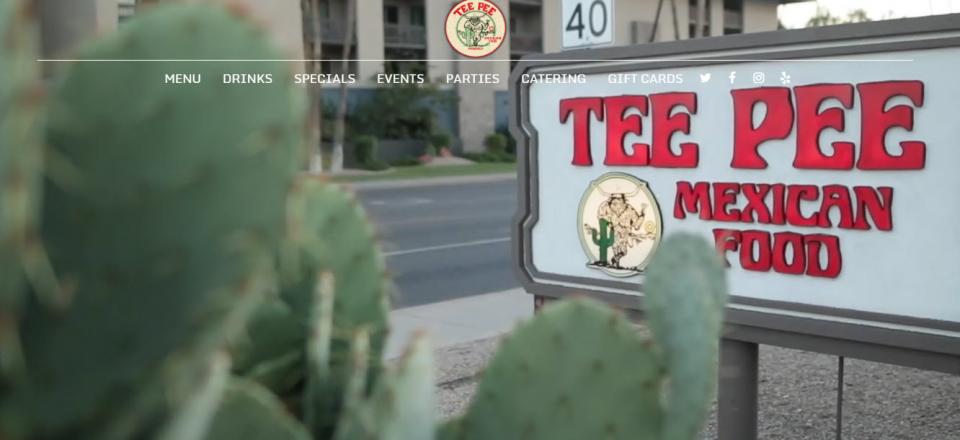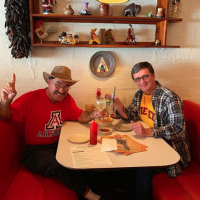A librarian and a folklorist walk into a bar
Two alumni dish on local gastronomy, friendship, bygone movie sets, and inevitable change
East Phoenix’s Tee Pee Mexican Restaurant has served the Arcadia district since the late 1950s. My family started visiting this revered neighborhood icon when I was nine years old. I recall that its original name, The Tee Pee Taproom, led me to expect tap dancing performances of the sort I had seen in grade school talent shows. Not so, but the food was magnificent, and the Mexican American family who founded it have maintained its quality and popularity for three generations.
I met a colleague, Department of English alumnus and retired Instructor Jon Drnjevic, for drinks and dinner at the Tee Pee last January—pre-pandemic shutdown. We talked about our experiences growing up in the neighborhood as we sat in the main dining room, surrounded by décor that probably hadn’t changed since the mid-twentieth century. Hanging from stone veneer walls, Christmas tree lights encircled commercial regalia of a different age: bullfighters, marlins, serape-clad campesinos, and a huge set of bull’s horns spearing a miniature sombrero. The booths sported archaic red vinyl seats and the Tee Pee logo—a bull perched on his hind legs, leaning on a saguaro cactus and holding a margarita—leered drunkenly from various points along the wall. I’ve always suspected that I’ve unknowingly shared the dining room with contemporaries from the neighborhood. Jon said that he frequently ran into friends from the old days in the restaurant, one in particular. “I meet my high school buddy every week on Thursday [at the Tee Pee],” he revealed.
Jon and I had both attended Arcadia High School and had grown up within a mile of each other, even though we wouldn’t meet until decades later, as ASU colleagues. Jon’s family home, in which he lives to this day, lies just north of Camelback Road and 40th Street, in the shadow of Camelback Mountain and the Praying Monk. While we differ in age by some ten years, we shared similar experiences growing up. We reflected on the Baby Boomer demographic of the neighborhood, with a much more visible presence of children and adolescents than appears to be the case now. And we both remembered the ubiquity of the bicycle in the youth culture of our day. “That was the Arcadia neighborhood,” Jon reflected, “riding around on bikes. I had the latest Schwinn, with a gearshift on it. Banana seat and a gearshift. That was the latest thing to have.” We concluded that the gangs of kids on bikes in Steve Spielberg’s film ET were surely influenced by the filmmaker’s upbringing in the neighborhood. Spielberg had attended Arcadia High School in the early 1960s, just before my freshman year.
As I contemplated my chimichanga, I recalled the admonition of cartoonist B. Kliban that you should never eat anything bigger than your head.
When Jon graduated from Arcadia in 1977, he moved to Indiana to attend Valparaiso University, “which was a flight across the country and a long way from home. It was kind of good.” As would be expected from a Phoenix boy, he underestimated the weather. His aunt and uncle came to his rescue and made sure that he was equipped with a wardrobe that would survive the ferocity of a Midwestern winter.
After earning BAs in English and political science in 1981, Jon returned to Arizona. He worked for some time at Best Western Hotels and Resorts, finally returning to academia in 1989. He enrolled in ASU’s MA in English program and received his degree in 1992. While later pursuing his PhD in British literature, he worked with Professor O M “Skip” Brack, Jr. who years later became a resident of the Arcadia neighborhood. “He was the best of mentors,” Jon reflected on his association with Brack, who passed away on November 8, 2012. While working on his PhD (1997), and later earning an MA in library science (University of Arizona 2006) and a BS in finance (W.P. Carey School of Business 2004), Jon began a long association with ASU’s Hayden Library, beginning at the help desk and working his way up to reference librarian. Finally, he accepted an instructor appointment in the English department.
Today, Jon is retired, but teaches part-time as an adjunct. He is an avid traveler and enjoys visiting the Arcadia neighborhood’s many restaurants, with the Tee Pee high on the list. He takes pleasure in the companionship of his black cat, Professor Snape. He is also taking online classes in religious studies. “So I’m resting with five degrees,” he explained, “and I’m in pursuit of number six.”
We paused to place our orders. Jon selected his usual—a chicken burrito with a side of beans—and I opted for a red chili chimichanga with guacamole, sour cream, beans, and rice. We returned to our drinks and chips and continued our remembrance of things past. I asked Jon what he recalled of his time at Arcadia High School. “Football assemblies,” he replied, referring to the exhilarating chaos of the pre-game high school pep rally (attendance mandatory). The sacred rituals of football were central to the student experience at Arcadia, especially the annual tribal rivalry called the homecoming game, in which the Arcadia Titans confronted their blood enemy, the Scottsdale High School Beavers. Reports of reciprocal vandalism have entered legend. It was said that at homecoming time, a gigantic “A” was secretly burnt into the grass on the Scottsdale High football field. A variant suggests that the Arcadia marching band did the deed, emptying packets of rye grass onto the field when they formed the “A” as part of their marching routine.
Our discussion turned to one of our favorite teachers. Bob Finkbine taught American history at Arcadia in a fashion unheard of in the day. At what seemed the beginning of every class, he wrote on the board in bold letters, “HISTORY IS AMBIGUOUS”—anathema, at the time, to the ultra-conservative John Birch Society mentality that had swept the land. And yet, Finkbine was allowed to practice his unique pedagogy, which included bringing history to life with dramatic and musical performances (Jon remembered him coming to class once dressed in buckskins). In 1960s Phoenix, where rote learning was the rule of the day, Finkbine’s style stood out and made its mark on his students. He was “very well remembered,” Jon said, recalling sharing a beer with him on the Tee Pee’s patio after he had retired. Bob Finkbine died at the age of 88 in October of last year.
The restaurant had filled up by the time our food arrived on thick white ceramic plates heated in the oven. As I contemplated my chimichanga, I recalled the admonition of cartoonist B. Kliban that you should never eat anything bigger than your head. Clearly, there would be leftovers for a late-night snack. We dug in, continuing our discussion between bites. I asked Jon if he remembered Cudia City, a film studio that produced westerns in the 1950s. Jon had been born after the studio’s heyday, but his parents had told him stories of chase scenes on horseback filmed in the wash behind their house, and of sets such as the saloon, built at the present site of Chelsea’s Kitchen and The Phoenix Country Day School. I remembered sneaking into the studio’s warehouse after it closed and playing in the sets. The lot was cleared for subdivisions and office buildings in the early 1960s.
We spoke of other changes we had seen in the neighborhood over the decades: of the old gas station on the corner of 40th Street and Campbell Avenue, now the restaurant La Grande Orange, and the wine bar Postino, formerly a post office; of a wonderful bar in a cottonwood forest on the edge of the canal called The Monastery, now gone along with the great Ingleside citrus groves on the canal’s far side. Gentrification and time have had their way with the neighborhood we remember, but The Tee Pee will always be, to quote the title of the novel by Robert Penn Warren, a place to come to.
Image 1: A screenshot of the Tee Pee Mexican Food website showing the restaurant's sign and logo.
Image 2: Jon Drnjevic (right) and his high school buddy, Kevin Riley (NOT this article's author), enjoyed libations at the Tee Pee during the ASU vs. U of A football game in 2019. Riley's questionable choice of colleges can be forgiven since he appears to have great taste in food—and friends. Courtesy photo.
Image 3: "The alluring Professor Snape," as Jon Drnjevic refers to his feline companion. Photo courtesy Drnjevic.
Image 4: Screenshot of a scene from a 26 Men episode called "Trade Me Deadly." The Western series was filmed at Cudia City film studio in Phoenix. Video from Western Films on YouTube.



